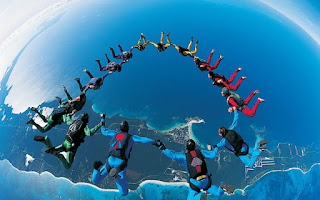10. Kite Skiing
As if snow skiing is not exciting enough, some extreme sportsmen have invented kite skiing. It entails the use of a traction kite and a harness to pull a skier across the snow and into the air. While this is ideal in wide-open fields or frozen lakes, there are some who have taken the sport even further and have kite skied downhill along snow-covered mountainsides.
9. Highlining
We have all seen the tightrope act in the circus. Some clown will cross a high and tightly taut wire while using a balancing pole with a net below to catch him in case he makes a misstep. In highlining, the wire is also located high up in the air.
But that is where the similarity ends, as in highlining, there are no balancing pole, no net to catch you in case you fall, and the wire is not stabilized and taut. Crossing a slack wire is infinitely more difficult than a tightly wound one, and combining that with the thought of the absence of a safety net, the danger level is increased exponentially.
8. Cave Diving
The famous Jacques Costeau pioneered this sport. It entails diving into underwater caves. And that is where the danger lies. In case your equipment fails, the cave makes it hard to make a quick ascent to the surface. Currents in underwater caves are also notoriously unpredictable. Visibility is also a problem because any wrong move will stir up sediments and cloud the view.
7. Volcano Surfing
This sport entails climbing up a volcano, then surfing down its side by sliding using plywood boards. The boards are reinforced by steel, metal or Formica. You can do it while sitting down, though veterans of the sport can do it upright. It sounds easy enough, until you start hitting sharp volcano rocks.
6. Ice Climbing
Those who live in areas where the winter is fierce can try out ice climbing. It involves scaling formations of vertical ice, like frozen waterfalls and cliffs covered with ice. The old method used for the sport is step cutting, which entails chipping out ice with an icepick to create your own foothold.
The British was able to invent in the early 20th century a device called the cramp-on, which allowed the fastening of toothed claw to the climbing boots. This has since been the basis of all advancements made in the sport. Of course, the aim is to speed up the climbing time and minimize the chance of getting numb because of the cold.
5. Wingsuit Flying
Imagine flying off a tall structure like a superhero. Wingsuit flying entails jumping off a perch and gliding down to the ground while wearing wings. These suits have an estimated glide ratio of 2.5 meters for every meter of descent.
Only those with at least 200 skydives are allowed to try this sport. It is that dangerous.
4. Free Soloing
Rock climbing in itself is already a difficult sport. Imagine removing all the safety ropes, harnesses and other equipment that can aid you in case you slip up. That is what free soloing is all about. They need to be able to support their entire weight using just their fingertips and toe tips, while maintaining intense concentration lest they fall off. One tiny mistake and that’s it.
3. Tow-In Surfing
Surfers love to drop off from the highest of waves, some of which are as tall as skyscrapers. The problem is how to get and latch onto the waves in time, as the waves move so quickly that it is extremely difficult to paddle into them. With the invention of the Jet Ski, however, the problem seems to have been solved.
Surfing stars like Laird Hamilton and Dave Kalama can attest to the rush brought about by this technique. Of course, now that they are able to reach the top of the wave, they now face another problem of being thrown into sharp reefs or being held down underwater in case of a wipeout.
2. BASE Jumping
This is the most dangerous recreational sport in the world, with one death recorded for every 2,317 jumps. Jumpers throw themselves off one of the BASE structures, meaning from a building, antenna, span or bridge, and earth or cliffs. Parachutes are then deployed for a safe landing.
It is sort of similar to skydiving, only you will have a much shorter time of reacting in case a parachute fails. If the parachute does fail, death is almost a certainty.
1. Creeking
This is whitewater kayaking taken to the limit. In the 1980s, as more durable kayaks were built, extreme kayakers thought of using their ride to plunge off high waterfalls. The adrenalin rush brought about by the plunge is further increased by the thought of hitting into jagged rocks or being sucked down below the water.





































facebook
twitter
google+
fb share